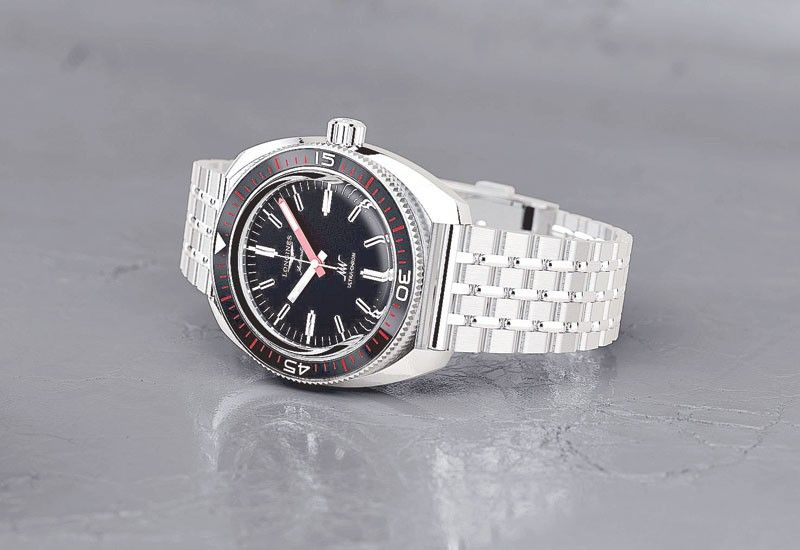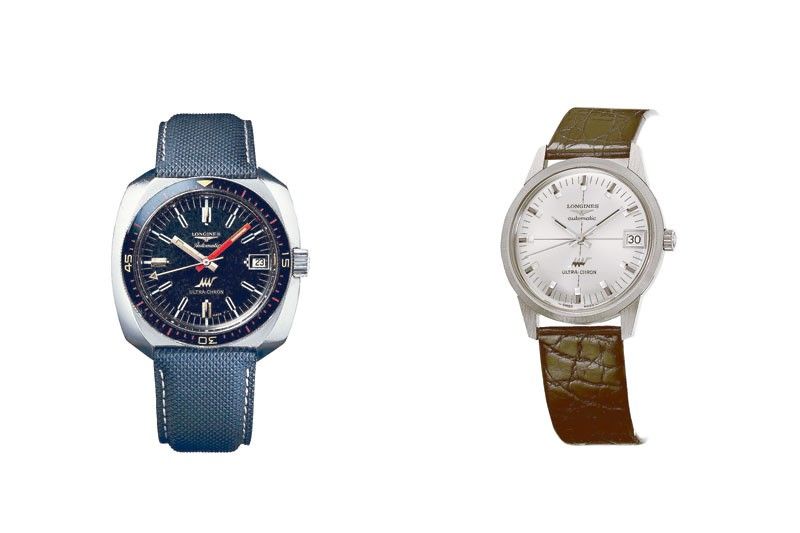The rebirth of a high-frequency icon: The longines ultra-chron

MANILA, Philippines — Longines is launching a new timepiece which is distinctive for its high precision: the Longines Ultra-Chron. The new high-frequency movement benefits from Longines’ rich heritage of producing high-beat movements for over 100 years. Inspired by the original Longines Ultra-Chron Diver of 1968, the new model reflects the iconic design codes of its ancestor.
In 1968, Longines launched the Ultra-Chron Diver, the first dive watch to be equipped with a high-frequency movement. At the time, Longines had already established itself as a pioneer in high-frequency technology. In fact, the winged hourglass brand created its first high-frequency timekeeping device to measure precisely 1/10th of a second as early as in 1914. In 1959, Longines developed the first high-beat movement for a wristwatch, an observatory chronometer that set new records in terms of accuracy.
The new Longines Ultra-Chron is inspired by the aesthetic codes as well as the professional dive features of the 1968 model. It features a unidirectional rotating bezel as well as a screwed-in caseback and crown. It also offers great legibility and is water-resistant to 30 bar (300 meters).
The Longines Ultra-Chron’s instantly recognizable 43mm cushion-shaped steel case is fitted with a diving bezel that boasts a sapphire insert with luminescent accents. The eye-catching black grained dial features a white minute track with alternating Super-LumiNova-coated batons and rhodium plated appliques.
Movements
The original Ultra-Chron logo is proudly applied on the dial and embossed on the caseback. The new Longines Ultra-Chron has a distinctive red minute hand which, like the hour hand, is coated with Super-LumiNova for optimal legibility.
At the heart of the new Longines Ultra-Chron is the calibre L836.6, a high-frequency in-house movement. A watch is referred to as “high-frequency” when it is fitted with a movement whose balance-spring oscillates at 36,000 beats per hour (10 beats every second). These movements, which Longines pioneered in 1914 (to time 1/10th of a second) and 1916 (to time 1/100th of a second), improved precise timekeeping. From 1959 onwards, Longines made use of the high-beat movements to increase the accuracy of its watches. Thanks to a reduction of the disruptive effects of shocks and of changes in the position of the movement, the high-beat movement proves to be more stable.
The accuracy of the Longines Ultra-Chron is confirmed by the chronometer certification issued by Timelab, an independent testing laboratory located in Geneva. This certification refers to the precision of the watch head.
The Longines Ultra-Chron is available with a choice of a leather strap or a steel bracelet and it is delivered in a special presentation box containing a black NATO strap crafted from recycled material.
The new Longines Ultra-Chron will evoke an emotional response from any watch aficionado who is passionate about the iconic timepieces from one of watchmaking’s most innovative eras. It will also win over new enthusiasts who will be thrilled to wear a piece of horological history on their wrists.
With centuries of watchmaking expertise, Longines has played a pioneering role in a number of technological advances and continues to display an unwavering commitment to innovation. Its constant pursuit of excellence has, in turn, led it to equip all of its automatic timepieces with state-of-the-art movements which, notably, include a silicon balance-spring. This material is not only light and corrosion-resistant but also remains unaffected by normal temperature variations and magnetic fields. Its unique properties improve the precision and longevity of the watch and allow Longines to provide its timepieces with a five-year warranty.

The timing of sports events with high-frequency instruments
Thanks to its highly accurate and reliable timepieces, Longines was requested to time the most important and prestigious sports events all over the world. Up to this day, this honorable task has motivated Longines to improve the precision and accuracy of its watches and to develop ever better timing equipment.
Equestrian sports
As early as 1878, Longines had developed its first chronograph movement, which was soon fitted in a case engraved with a jockey and his horse. These stopwatches were seen on the American racetracks in the 1880s, where they proved very popular among jockeys as well as the people attending the races. In 1912, a new step was taken when Longines entered into its first official partnership with a show jumping event in Lisbon, Portugal. Throughout the years, Longines has timed thousands of equestrian competitions.
Alpine skiing
Skiing down snowy mountains ranks among the most popular sports in Longines’ home country of Switzerland. In 1924, the brand timed the “International Week of Winter Sports” in Chamonix (France). Some years later, the stopwatches from Saint-Imier were timing the World Ski Championships at the same place. In 1939, Longines presented a skiing timer with a high-beat movement and split-second hand, measuring 1/10th of a second. For the Military Ski Championships in Crans-Montana (Switzerland) in 1945, Longines introduced a photocell light barrier on the finish line. In 1948, Longines was selected to time the legendary Kandahar downhill race in Sankt Anton (Austria). The organizers of the Ski World Championships of 1950 in Aspen (USA) chose Longines to be the Official Timekeeper. Today, Longines is the Official Partner and official Timekeeper of the FIS Alpine Ski World Cup tour and the FIS AlpineWorld Ski Championships and continues to time the most famous ski races in the FIS Alpine Ski World Cup, including, among many others, the downhill races in Kitzbühel (Austria) or LauberhornWengen (Switzerland).
International rallye-sport
In January 1949, cars from all over Europe participated in the first edition of the Rallye Monte-Carlo after World War ll. Timekeeping was entrusted to Longines, a status it held for more than 30 years. In 1955, the brand from Saint-Imier launched a special punch printing device, called Printogines. Equipped with a clock with an eight-day power reserve, it allowed contestants to punch their own control card at each checkpoint over the more than 5,000 km distance. The reliable and robust device determined the official winning times on the basis of the drivers’ recorded passages through all checkpoints. It was so useful that it was appointed to time all the famous rallies of its period - including the Coupe des Alpes, the RAC Rally of Great Britain, the TAP Rally in Portugal, and the Thousand Lakes in Finland as well as the Rallye Acropolis in Greece and the Rallye de Cöte d’Ivoire in Africa.
Cycling races
In 1951, Longines was asked to time the world’s leading cycling event, the Tour de France. The race across France was an excellent opportunity to test a new system that combined a camera at the finish line with a device recording each contestant’s time on film. This timing system solved the photo-finish problem when closely grouped competitors reached the line at nearly the same time. The former president of the French Cycling Federation, Jean Pitallier, personally timed every edition of the Tour de France from 1973 to 1980 with a pair of Longines high-frequency split-second stopwatches (ref. 7411). Longines was Official Timekeeper of the Tour de France until 1982 but its commitment to cycling went far beyond that: from 1954 until 1988, Longines timed the world track and road championships 28 times, as well as such renowned events as the Giro d’ltalia or the Vuelta in Spain.
Formula 1
In 1949 Longines introduced a timing system for motor races capable of recording 1/10th of a second via a series of photos. It was so convincing that the International Automobile Federation certified it in 1950. In the same year, the inaugural season of Formula 1, Longines timed the famous Grand Prix de Monaco and the Indianapolis 500 in the USA as well as Formula 1 races in Barcelona (Spain), Buenos Aires (Argentina), Spa (Belgium), Zandvoort (The Netherlands), and Bern (Switzerland) along with numerous other racing events in the following years. By 1954, Longines had developed Chronotypogines, which used a sensor to automatically start and stop time. This system was soon adopted by the International Automobile Federation. In 1980, Longines launched (with Olivetti) a new method to time each car independently by using radio waves. This led to Longines’ role as Official Timekeeper for all Formula 1 races from 1982 to 1992.
Based in Saint-Imier in Switzerland since 1832, the watchmaking company Longines wields expertise steeped in tradition, elegance and performance. With generations of experience as official timekeeper of world championships, and as partner of international sports federations, Longines has built strong and long-lasting relationships in the world of sport over the years. Known for the elegance of its timepieces, Longines is a member of Swatch Group Ltd., the world’s leading watch manufacturer. The Longines brand, with its winged hourglass emblem, is established in over 150 countries.
For information, visit www.longines.com.



















